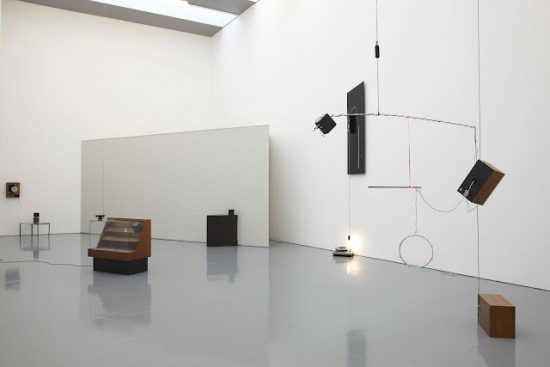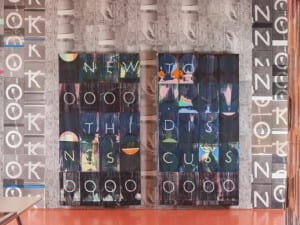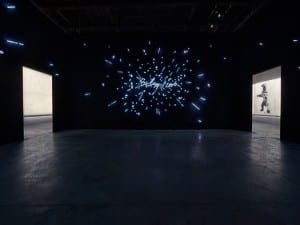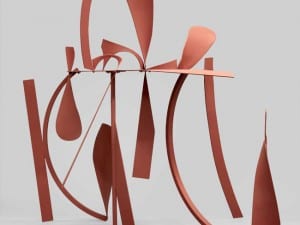Text by Regina Papachlimitzou
In his first UK solo exhibition, Silver Lion Award winner of last year’s Venice Biennale, Haroon Mirza unfolds the map of an uncharted soundscape at once inviting and forbidding. His show /|/|/|/|/|/|/|/|/|/|/|/|/|/|/|/| (the title being the “typographic representation of a sawtooth waveform” –that is to say, the representation of sound waves) consists of installations in which the auditory element heavily outweighs the visual. Each installation is pervaded by its own distinct mood, but all share a common denominator in the intensity of the experience and of the response each work elicits.
The artist has created a sense of insularity in which to experience his work through a spatial intervention in the galleries of Spike Island: the familiar rooms have been broken up and reassembled beyond recognition, with the help of temporary structural elements such as walls and latticed flooring. Upon entering what used to be Spike Island’s largest gallery, the visitor is almost sucked in, as if by a black hole, into Mirza’s award-winning The National Apavilion of Then and Now . Through a pitch black corridor soundproofed with thick, carpet-like material that swallows the sound of your footsteps, you walk into the unknown guided by a droning sound.
At the end of the corridor you find yourself in a dark and narrow triangle-shaped room, soundproofed with triangular pieces of dark grey foam jutting out from the walls. Overhead, a halo of white LED lights is the only light source, distorting the surface of the walls into apparent movement. The drone rises in pitch and intensity, the vibrations travel up through your body from the metal grille floor. When the lights and sound abruptly cut off, you are left in absolute darkness with the only sound a faint reverberation seeping through from the installations in the adjacent galleries; the only light a haunting afterimage of the LED halo. At that breathtaking moment you are engulfed by an overwhelming, absolute aloneness: a strangely welcome lack of any sort of context, temporal or spatial.
Once you’ve pried yourself away from the magnetic hold of National Apavilion, head to the gallery hosting I Saw Square Triangle Sine. The spatial arrangement of the installation -in the centre of the room on a raised platform- creates the effect of walking into a performance space, a recently abandoned set on which the instruments are still pulsing with life. The sculptures have clearly been positioned to bring to mind a band, including decks, drums, a keyboard, microphones and amps. This effect is however undercut by the physical reality of the undulating feedback noise, the sound of no music being produced at all. There is something distinctly menacing in the continuous rise and fall of the sound waves, intensified by the fact that the invisible line separating artwork and visitor is here erased: the visitor is welcome to play the drums or listen to the earphones, thus melting through the invisible barrier into the installation.
The adjacent space, set up as a corridor lined with sky blue foam, provides a welcome break from the intensity of the auditory experience that is The National Apavillion and Square Triangle. The mutedness and light spilling across the space sharply contrast with the sense of engulfment created by the previous installations. With head still vaguely throbbing, the visitor can examine a mixture of preparatory drawings for installation projects: some with the playful, careless quality of pencil drawings, thoughts absent-mindedly scrawled on paper; others precise, colour-coded diagrams with explanatory keys and notes. The juxtaposition of the doodle-like notes and almost mathematical blueprints make for a tongue-in-cheek reminder of the mixture of flash of inspiration and meticulous planning that inhere in the creation of any artwork.
The break, however, does not last long: already the exacting clamour of Untitled Song featuring Untitled Works by James Clarkson next door flows in and penetrates the visitor’s consciousness. Entering the adjacent gallery you are greeted by a symphony of energetic sound-snatches running alongside each other, collapsing, and dividing again. As time passes, different installations come alive at different points, gradually building a soundscape as if in reaction to each other and to the visitor.
A small, barely noteworthy speaker next to the entrance suddenly gives out an authoritative thump that vibrates its surface; from the other end of the room, a contraption made up by a wall-mounted speaker, a ceramic lamp, and a glass table responds and develops the thumping. In the centre, a modified shop display case, empty but for a lonely small speaker inside it; above it, a chain is suspended with its end curling on a woofer. As if swept along by the soundwaves rising and falling across the room, this installation comes to life too: the vibration travelling through the ear forces the chain to dance, adding its own jangle to the orchestra. Close to the entrance, suspended from the ceiling hangs a mobile-like structure, made up of a visibly vibrating small speaker, a string of red LED lights, a drum rim, and two more speakers on the other end. Across the room lies an old-style turntable with an analogue radio spinning on it, strongly echoing the decks of Square Triangle; an energy-saving bulb overhead sheds intense white light and creates a not unpleasant grating sound crossed with the static emitted by the radio spinning past. Untitled Song employs the lyricism of looped feedback and static sound waves to create an auditory experience precariously straddling the border between noise and music. The use of muted speakers through which music –presumably- flows only to be discarded in favour of the pure sound of vibrations renders the work all the more poignant.
In /|/|/|/|/|/|/|/|/|/|/|/|/|/|/|/| the most promising young artist of the 2011 Biennale has put together a daring, original, and deeply moving solo exhibition that helps to carve a distinct niche for sound art in the landscape of the contemporary art world.
Haroon Mirza: /|/|/|/|/|/|/|/|/|/|/|/|/|/|/|/|, 21/01/2012 – 25/03/2012, Spike Island, 133 Cumberland Road, Bristol, BS1 6UX. www.spikeisland.org.uk
Aesthetica in Print
If you only read Aesthetica online, you’re missing out. The February/March issue of Aesthetica is out now and offers a diverse range of features from an examination of the diversity and complexity of art produced during the tumultuous decade of the 1980s in Art, Love & Politics in the 1980s, opening 11 February at MCA Chiacgo, a photographic presentation of the Irish Museum of Modern Art‘s latest opening, Conversations: Photography from the Bank of America Collection. Plus, we recount the story of British design in relation to a comprehensive exhibition opening this spring at the V&A.
If you would like to buy this issue, you can search for your nearest stockist here. Better yet call +44 (0) 1904 629 137 or visit the website to subscribe to Aesthetica for a year and save 20% on the printed magazine.
Captions:
Haroon Mirza
Installation view, Untitled Song featuring Untitled Works by James
Clarkson, 2012. Mixed media.
Photo: Stuart Whipps. Courtesy the artist and Spike Island.





